Explore the evolution of the innovation cycle: Why are excess returns often harvested by secondary developers?

Reprinted from panewslab
04/20/2025·1MAuthor: Saurabh Deshpande
Compiled by: Felix, PANews
If you witness what is happening on the chain, you may feel like the end of the world is coming. It can even be said that artificial intelligence has replaced cryptocurrencies and has become a hotbed for future technological development. All of these statements make sense, but it is best to look at the problem from a more macro perspective.
This article explains how the innovation cycle gradually evolves to achieve the technology finding a market fit. Today’s story will dive into what is common between Uber, Pendle and EigenLayer. I hope it can help you dispel the pessimistic arguments on Twitter and find a new perspective.

For thousands of years, humans have been believed to be unable to fly. In the 112 years since humans first flew, ways to capture rockets returning from space have been found. Innovation seems to be a gradual variant that spans the times .
The true magic of technology is rarely reflected in its original invention; it lies in the ecosystem that was born around it. It might as well be considered as compound growth, but innovation rather than money.
While pioneers who create new things will grab headlines and gain venture capital, it is often the second wave of builders who can tap into the greatest value—those who discover untapped potential in their existing foundations. They see possibilities that others cannot detect. History is full of innovators who have never predicted how their inventions will reshape the world. They are just trying to solve the problem at hand. In the process, they open up possibilities far beyond the original vision.
The best innovation is not the end, but the launch pad that allows a brand new ecosystem to take off. Today's article will explore how this phenomenon appears in Web3. Start with the Global Positioning System (GPS) that is used every day and then trace back to the cryptocurrency space through restaking and points mechanisms.
A weekend that changes the internet
Since its inception in 1973, the Global Positioning System (GPS) has been committed to precisely positioning the Earth. But Google Maps is much more than that, allowing billions of people to access, use and understand this raw data.
Google Maps began with three strategic acquisitions at the end of 2004.
First there are Where 2 Technologies, a small Australian startup that works in a one-bedroom in Sydney. They developed "Expedition", a C++ desktop application that uses pre-rendered map tiles to enable smooth navigation. Compared to MapQuest's clumsy experience, its user experience is even more excellent.
Meanwhile, Google acquired Keyhole (satellite image technology) and ZipDash (real-time traffic analysis), integrating the core of its map vision. Together, these acquisitions form the basis of Google Maps: blending interactive navigation, rich visual data and dynamic information into one application.
Expedition is a desktop application, but Larry Page insists on a web-based solution. The initial attempt was slow and unremarkable. Stanford graduate Bret Taylor, who was formerly a Google side product manager, started to fix the problem.
Bret Taylor rewrites the entire front-end with asynchronous JavaScript and XML (AJAX). AJAX is an emerging technology that allows websites to update content without reloading the entire page. Before AJAX, web applications were static and bulky. But with AJAX, the response speed is comparable to that of desktop software. Maps become draggable, and new tiles load without refreshing pages – a revolutionary user experience in 2005.
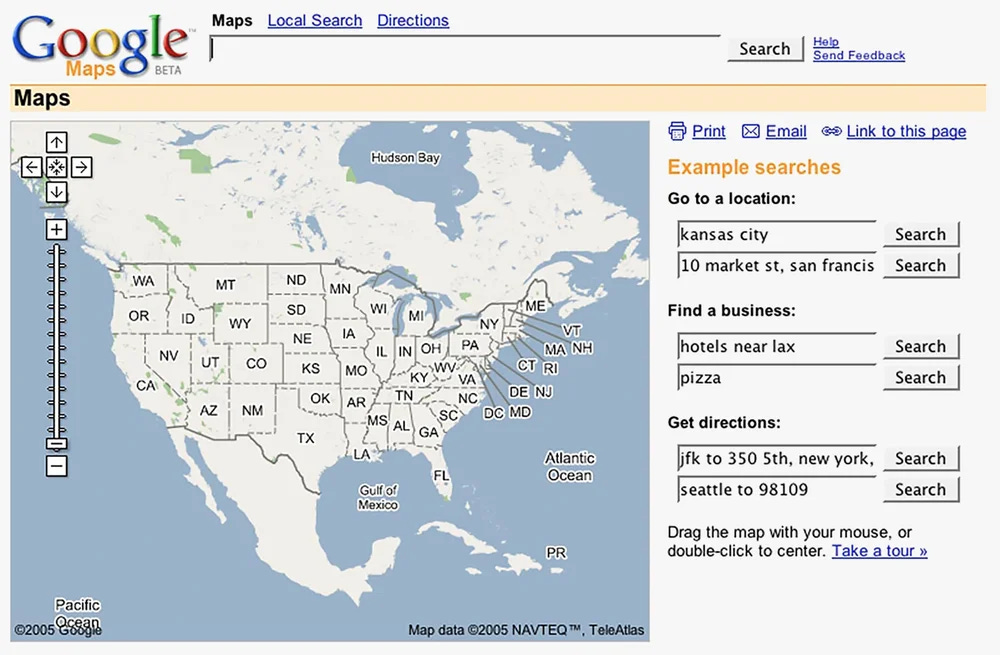
The real genius is that Google released the map API later that year, transforming it from a product to a platform. Developers can now embed Google Maps and develop on this basis, which has triggered thousands of "mashups" projects that eventually develop into complete business. Uber, Airbnb and DoorDash exist because Bret Taylor made the map programmable on a decisive weekend.
Bret Taylor’s intuition is a recurring phenomenon in the field of technology: the most profound value often comes from the foundation, but from the results built on it by others. These "second-order effects" represent the true composite magic of innovation—a breakthrough that can empower the entire ecosystem and produce unexpected applications.
After Google Maps is programmable, it triggered a chain reaction. Airbnb, DoorDash, Uber and Zomato were the first to join in bringing GPS to the core of their services. Pokémon Go goes a step further, superimposing augmented reality technology on location data, blurring the boundaries between reality and virtuality.
What is behind all this? Of course it's payment. Because if payment cannot be made seamlessly, what is the use of on-demand service?
The GPS technology they rely on is nothing new. But GPS alone cannot create miracles. It is the pinnacle of decades of technological evolution, such as satellite positioning, mobile hardware, AJAX, APIs and payment channels, all of which are quietly taking shape.
This is why the second-order effect is so powerful. They are rarely noticed at the moment. But one day, you look up and you will find that your daily affairs are being coordinated by an invisible innovation network that has quietly accumulated over the years.
How to re-pled produce products
In June 2023, EigenLayer introduced the "re-staking" function to the Ethereum main network, completely changing the security landscape of Ethereum. The concept is novel yet simple and easy to understand, and anyone interested in cryptocurrencies can understand: "What if you could stake your ETH twice?"
In traditional staking, your ETH can get a stable but modest 3.5% - 7% gain. Re-staking is essentially a dual role for the same batch of ETH, which can not only protect the Ethereum network, but also protect the EigenLayer protocol network at the same time - the same funds, multiple sources of income, and improve funding efficiency.
By April 2024, EigenLayer had moved from a theoretical innovation to a fully operational system and received significant adoption. The data says it all: 70% of new Ethereum validators choose to join the protocol now. By the end of 2024, more than 6.25 million ETH (about 19.3 billion US dollars) were locked in re-staking. If ranked by the country with the highest GDP, it should be around 120.
It's not just EigenLayer that makes restaking a reality. But others followed suit. EtherFi is a liquid staking provider that quietly went online in early 2023.
ether. I expect EigenLayer's stake will be one of DeFi's most popular opportunities. You bet on ETH, get the ETH token, and then automatically re-bet on the feature layer. And, as a bonus, you can use eth and play in other DeFi sandboxes. Pandel is such a sandbox. It's like getting paid multiple times for doing the same thing--crypto finance, everyone.
Ether.fi expects EigenLayer's restaking to be one of the most popular opportunities in the DeFi sector. You stake ETH, get eETH tokens, and then automatically restake it on EigenLayer. And, as a bonus, you can take eETH to experience it in other DeFi sandboxes. Pendle is such a sandbox. It's like everyone gets paid multiple times for doing the essentially the same thing.
What is the result? It's quite impressive. By May 2024, Ether.fi's TVL soared to about $6 billion. Their "Liquid Vault" offers an annual interest rate of about 10%, and the average pledge wasn't that exciting at the time.
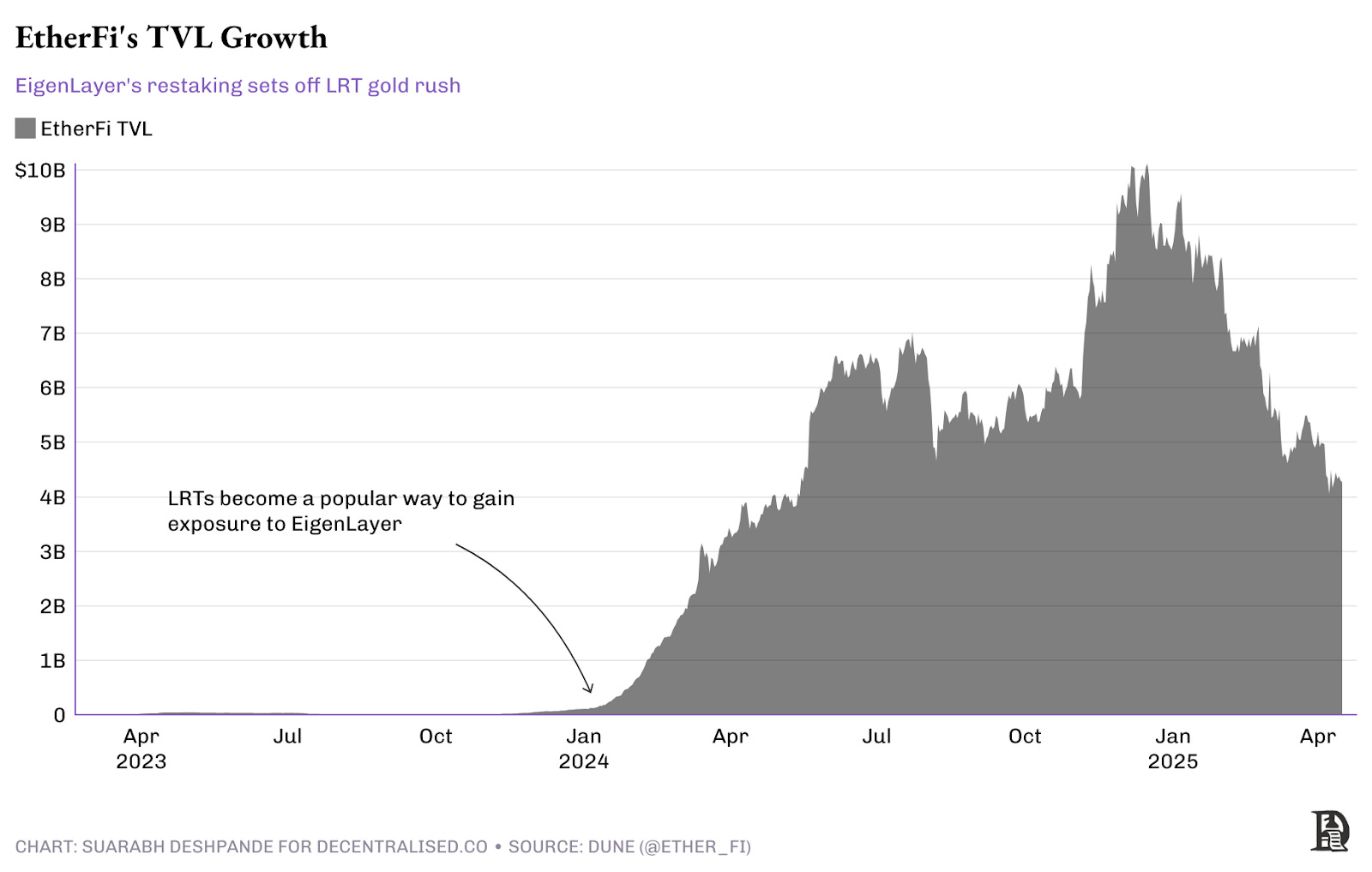
Ether.fi does the same thing that restaked ETH as Lido does before. Resolution becomes practical, mainstream and profitable by creating liquidity, accessibility and availability for resolution ETH.
In addition to chasing profits, there is also "point mining". People not only pursue immediate returns, but also accumulate "points", which may become valuable tokens in the future. If you want, you can call it a speculative flywheel. As more and more users re-stake through Ether.fi, more eETH tokens are circulated and deeply integrated with other DeFi projects such as Pendle, where you can trade future gains, and even points themselves, creating new financial instruments out of thin air.
About what happened to points – after all, cryptocurrencies are a paradise for efficient capital mercenaries. When the protocol starts to use points as rewards, a large number of users emerge to try to maximize points and manipulate the system in the process. The original intention behind points is to achieve a fairer and wider token allocation. But once it evolved into a competition, the result was deviation. The most active "miners" are not always the most consistent users. While many projects are still using points to distribute tokens, this strategy is no longer as attractive as it used to be.
So, as always, lessons are more than innovation. More importantly, the biggest winners are often not those who create something hotly discussed in the first place. They are the ones who come to the end, understand the actual situation, and create the right thing at the right time.
Of course, EigenLayer laid the foundation, but Ether.fi and other companies that saw the second-order effect also got a share, eventually accounting for more than 20% of the Ethereum staking market in mid-2024. In the crypto space, being the first person is far less important than knowing the best about what others are doing.
Points and Pendle
Points became mainstream in December 2023 after Jito airdrops were a huge success. The Solana-based agreement made its debut and received over $1 billion in FDV, setting off a "gold rush". Suddenly, the entire ecosystem's protocol has shifted from direct token allocation to points system. They began to reward users participating in the protocol with points, which can then be redeemed for governance tokens. This initial new distribution mechanism quickly evolved into a dominant strategy.
Pendle was launched in June 2021 and focuses on tokenization and future earnings trading. Pendle’s core innovation is clever because it divides earnings tokens into two parts: principal tokens (PTs) representing the underlying assets and earnings tokens (YTs) that capture future earnings. This separation allows users to trade these components separately, thereby gaining more control over their earnings strategy than before.
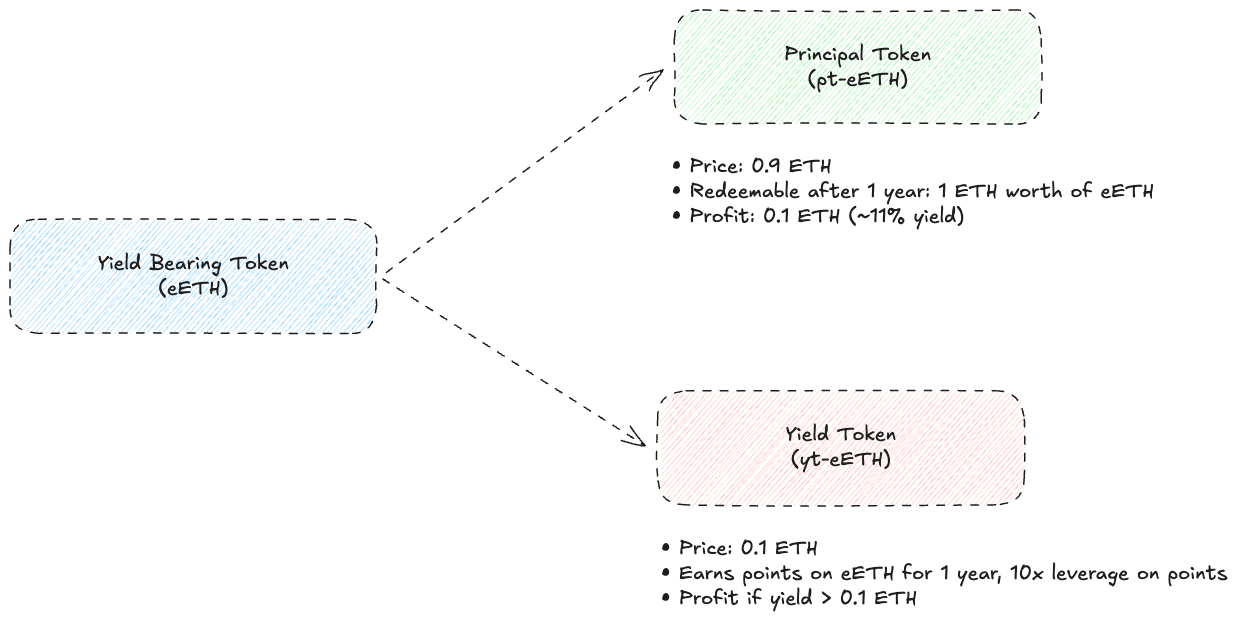
When the points contest officially began, Pendle found itself in a good position with a feature built for a completely different reason. The platform's YT token creates a mechanism equivalent to leveraged points mining. Users can obtain both floating income from assets and any related points, thereby expanding their points accumulation without additional funds.
Here is how it actually works. Suppose Sid wants to earn points from a protocol like EigenLayer that rewards liquidity providers. Traditionally, he needed to deposit ETH into a pledge contract at EigenLayer and lock the money for weeks or months. With the combination of liquidity re-staked tokens (LRT) and Pendle, Sid can purchase income tokens (YTs) representing future earnings and points without having to deposit ETH directly into EigenLayer.
For example, suppose the price of eETH is $2,000 and you can get 24 EigenLayer points per day. pteETH stands for fixed income tokens, and yteETH stands for floating income tokens, selling for $200. pteETH holders give up their points in exchange for fixed income. The yteETH holder receives floating income and points. Now, for just $2,000, Sid earns 240 (10 ETH worth) points per day instead of just 24.
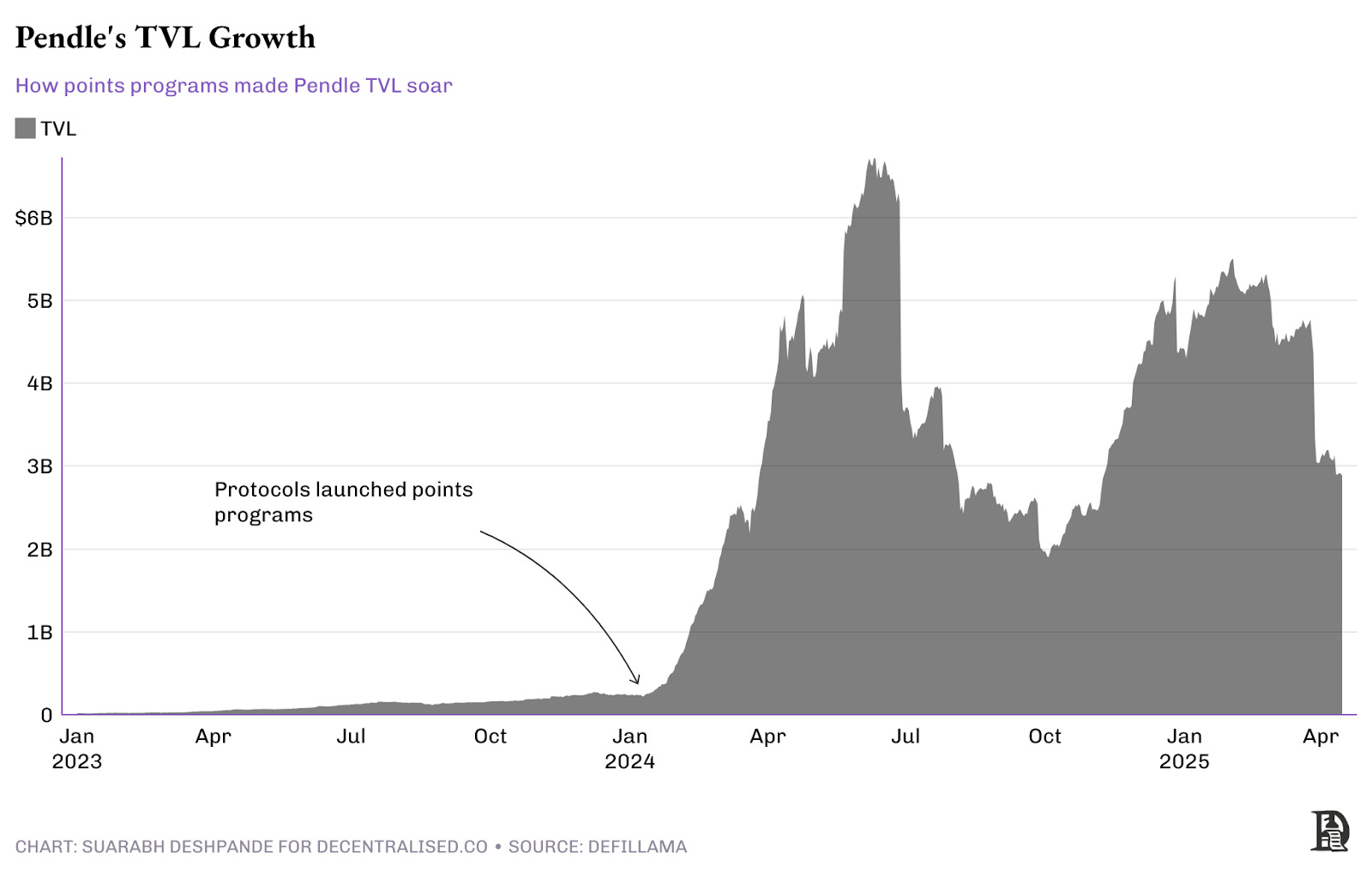
Pendle founder TN Lee has analyzed this in detail on the podcast. The team did not build a meta-architecture for points. They can't predict this. But they built the perfect infrastructure for this emerging behavior and gained a wealth of capital. Even if this trend eventually cools down and TVL drops to about $2.5 billion, their market cap is still 10-15 times higher than before the points appear.
Memecoins, Pump.fun, and Raydium
Sometimes, the second-order effect appears from the most unexpected places and revitalizes the entire ecosystem in the process. The 2023-2024 Solana revival is a brilliant case that fully demonstrates the rapid changes in cryptocurrencies and how those who position themselves at critical crossroads can gain value.
After the FTX crash in late 2022, many industry insiders wrote “obedoes” for Solana. This logic seems to be very reasonable. SBF and his company have a huge influence on the ecosystem, providing funding, liquidity and market support. Without them, Solana struggled. The technology is plagued by reliability issues, and the news of "Solana downtime" has become a laughing stock. The blockchain that once positioned itself as an "Ethereum killer" seems to be on the verge of dying.
Yet an extraordinary change is happening. Throughout 2023, Solana's technology has steadily improved. There are fewer and fewer downtime events. The finality of transactions and user experience are significantly smoother. Developers attracted by Solana's technical foundations such as high throughput, low cost and sub-second finality are starting to return, although they are cautious.
By the beginning of 2024, the situation had a decisive reversal. With disappointment with traditional DeFi governance tokens and a widespread turn to so-called "financial nihilism", users' attention and funds began to flock to memecoin. These tokens usually have little use except community ownership and cultural signals, but capture the imagination of the market. Solana provides the perfect environment for this new wave with its lightning trading speed and extremely low fees.
PumpFun went online in January 2024. This “memecoin factory” simplifies the token creation process (used by a developer expertise with programming skills) to be completed in just a few minutes. PumpFun democratizes token creation in a way that perfectly fits the spirit of cryptocurrency finance experiments. Almost overnight, thousands of new tokens called "BONK", "Dogwifhat" and "POPCAT" flooded into the Solana ecosystem.
The seemingly frivolous cryptocurrency quickly demonstrated its potential as a catalyst for complex value chains. These new tokens require something crucial: liquidity. Without a trading platform, even the cleverest memecoin concept would be worthless. The decentralized exchange Raydium, the Solana ecosystem, is in an enviable position.
Since its inception, Raydium has been committed to becoming Solana’s top trading platform, focusing on improving capital efficiency and reducing slippage. This protocol is not designed for memecoin. But its technical architecture proves to be similar to Uniswap's centralized liquidity pool and license-free token listing process, which is very suitable for dealing with the sudden influx of new assets.
The timing is just right. Years of infrastructure development have created the required solid foundation for this unexpected use case.

Listing on Raydium has become an important milestone for these emerging tokens, increasing credibility and visibility in an increasingly crowded market. By early 2025, this symbiotic relationship becomes crucial, with more than 40% of Raydium’s Swap revenue coming from tokens generated by PumpFun.
This relationship is mutually beneficial: PumpFun requires Raydium’s existing liquidity pool to boost its tokens from niche products to tradable assets, while Raydium flourishes with the explosive transaction volumes brought by these tokens.
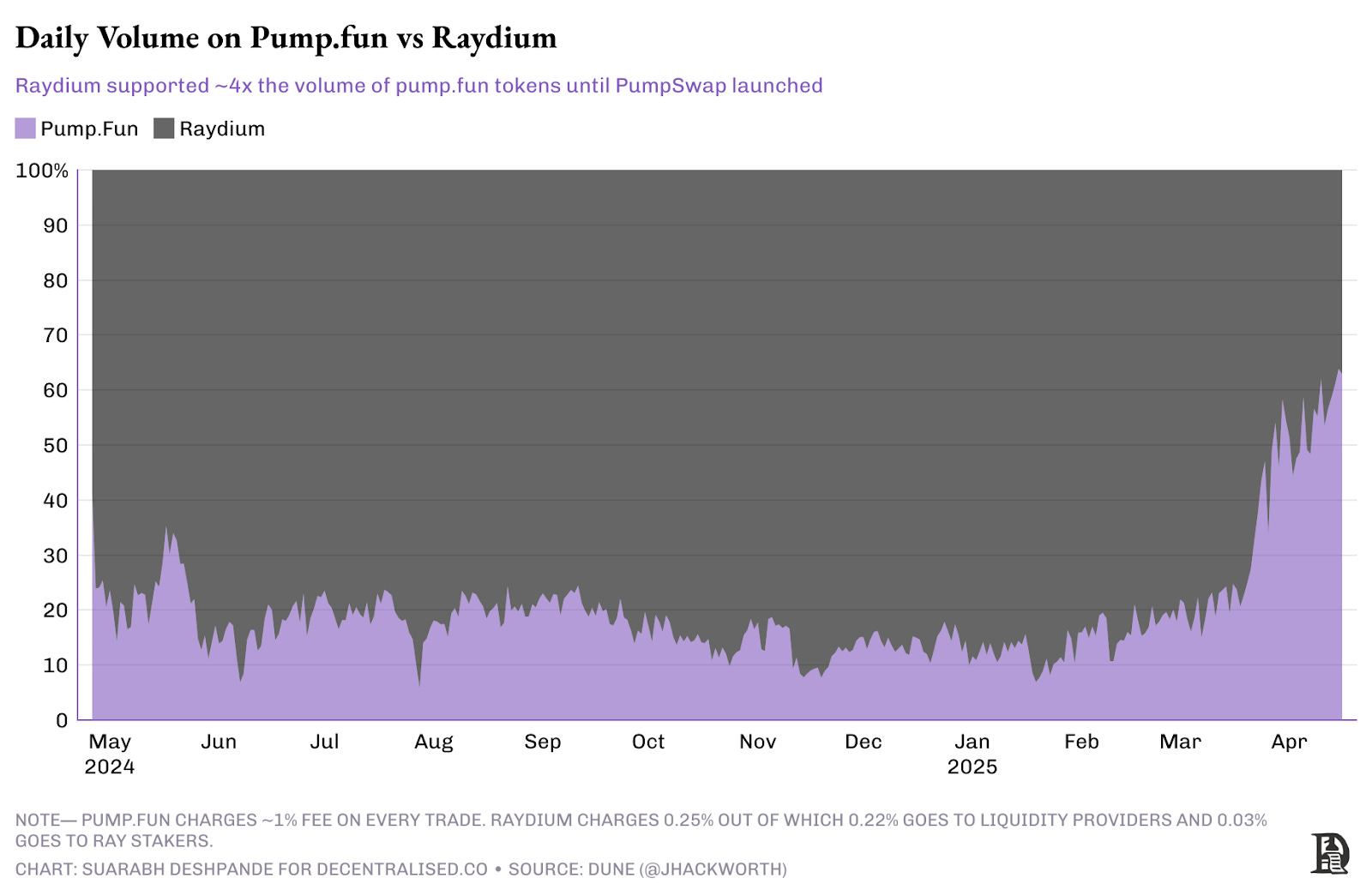
The economic benefits of the PumpFun team are also amazing: Tokens exclusively traded on the PumpFun platform charge a 1% handling fee per transaction, while Raydium's fee structure is 0.25%. This means that Raydium needs to create four times the volume to be on par with PumpFun’s per token revenue. Due to its deeper liquidity and a wider user base, Raydium has consistently managed to surpass this threshold between August 2024 and February 2025.
Raydium is not the original creator of memecoin, nor is it the first token factory concept. However, by providing a strong infrastructure for trading these assets and quickly responding to competitive threats, most of the value in the ecosystem has been seized.
The legend of Solana memecoin shows a key aspect of the second-order effect: Value is often not attributed to those who create new behaviors, but to those who promote new behaviors on a large scale. PumpFun simplifies token creation, while Raydium enables efficient price discovery and trading. Each innovation triggers further adaptation. PumpFun’s vertical integration initiative prompted Raydium to create LaunchLab and produced a series of secondary effects that reshape the entire ecosystem.
This concern not only revitalizes the ecosystem, but is also actively utilized. As the memecoin craze grows, tokens like Trump and Libra are likely to be launched for popularity. Their strategies rely on narrative, timing, and virality. Trump leverages the energy of political memes, while Libra leans towards a broader internet culture. Both tokens initially received a lot of attention and reached a ridiculous valuation shortly after launch.
But this energy didn't last long. Pay attention comes quickly and goes quickly. The secondary market cools down. The trader distracted. The community is gradually decreasing. What makes these tokens successful is that it shows how to capture attention at the right time and convert it into speculative gold. What they failed to do, however, was to maintain market value. They have no real practicality, no roadmap for sustained development, they are just a flash in the pan.
However, they proved a point of view: innovation can attract attention. And in the field of encryption, attention is one of the most powerful raw materials. If used properly, it can stimulate a new craze; if used improperly, it will soon die.
The lessons are obvious to observers of crypto innovation. When new primitives appear, it depends not only on direct impact, but also on who is best suited to promote, optimize and extend the behaviors they support. This is often the real realization of excess returns.
What to do now?
After reading this, you may be wondering what the next second-order burst will look like. Maybe you call it compound innovation, or maybe it is a fusion of technology, but the focus is the same. This article discusses the collision of multiple technologies at the same time, and the chain reaction caused by them is greater than the sum of their parts.
We have seen this happen: restaking reshapes the DeFi incentives, memecoin infrastructure revitalizes the entire ecosystem, and earnings agreements unexpectedly achieve airdrop leverage. So, what is the next fallen domino? Maybe it's the EVM experience. Maybe. It is indeed being rewritten, redesigned and refined to make it feel like real software – at least that’s the promise. Whether it will become the next great compound interest layer or just another gradual upgrade remains to be seen.
But if these links are smoothly connected, it may trigger an unprecedented chain reaction.
Behind the hustle and bustle of the L2 debate and expansion war, a competition is brewing – not only expanding Ethereum, but also improving its usability. True usability means allowing others to build on it without being troubled by problems such as wallets, handling fees or transaction failures. Because when friction disappears, innovation will flourish. And when innovation flourishes, compound interest returns will appear in the most unexpected places.
Over the past few months, some of the outstanding people who led the change have been received: Andre Cronje from Sonic, Keone Hon from Monad, and Shuyao Kong from MegaETH. Although their approaches vary, the goal is very clear: eliminate delays. Eliminate friction. Even eliminate the wallet. Replace it with something faster, smoother, and more invisible. Create a real software experience, not a tedious click process.
Both MegaETH and Monad claim to be able to process 10,000 transactions per second. This is equivalent to Solana's speed, but has the semantics of Ethereum. You should know that the encryption field has always tended to overstate it. If it can be realized, this will be the first EVM-based chain that puts Solana in a passive position in terms of user experience. (It's a little funny considering that the EVM blockchain has long been plagued by slow confirmation and hellish wallet pop-ups.)
Andre's publicity focus is not on pure speed, but on removing complexity. He said Ethereum's performance cap is far from reaching. According to him, its current operating capacity accounts for only about 2% of the total capacity. This is not due to hardware limitations, but because of the way Ethereum virtual machines (EVMs) access and write data. Sonic has reduced data storage requirements by 98% through its new database structure. His Sonic development roadmap bets on abstraction—abstract fees, abstract accounts, abstract wallets. If everything goes as planned, by the end of this year, users will not even realize that they are in the blockchain, and can maintain a considerable degree of decentralization. And this is the key.
So, who will win in this brand new world? It may not be the infrastructure teams busy refreshing the TPS benchmark, but the applications built on these infrastructures, such as Pumpfun, which leverages Solana's infrastructure, profiting $500 million in less than a year. Social protocols, in particular, may make breakthroughs. Projects like Farcaster have demonstrated the potential to combine the permanence of cryptocurrencies with the convenience of the network native. There is no need to pay for posting, no longer have MetaMask popups. Only content sharing.
Then there is DeFi. Next-generation financial applications require better input. Andre said bluntly: “We don’t have on-chain volatility, implicit volatility or real volatility.” When these data really appear, real options markets, coherent derivatives, and well-structured perpetual contracts are expected to appear—the financial layer that cryptocurrencies have always pretended to have already owned.
Perhaps the most exciting are those applications that have not yet been imagined. Because things always go like this. In 2005, no one would see Google Maps and say, “Do you know what it needs? Carpooling service.” But once the foundation changes, everything on it will change.
So, I am skeptical. Personally staying in the crypto space long enough, knowing that ten times the improvement promised each time will usually only get you a slightly better dashboard and more Discord notifications, but it's also very excited. Because this time, the underlying technology feels real. And behind them, a new generation of builders are silently committed to the second-level magic that may reshape everything. Because for every breakthrough underlying technology seen today, dozens of builders are already working on developing second-order applications that can demonstrate the true value of the underlying technology.


 chaincatcher
chaincatcher
 jinse
jinse